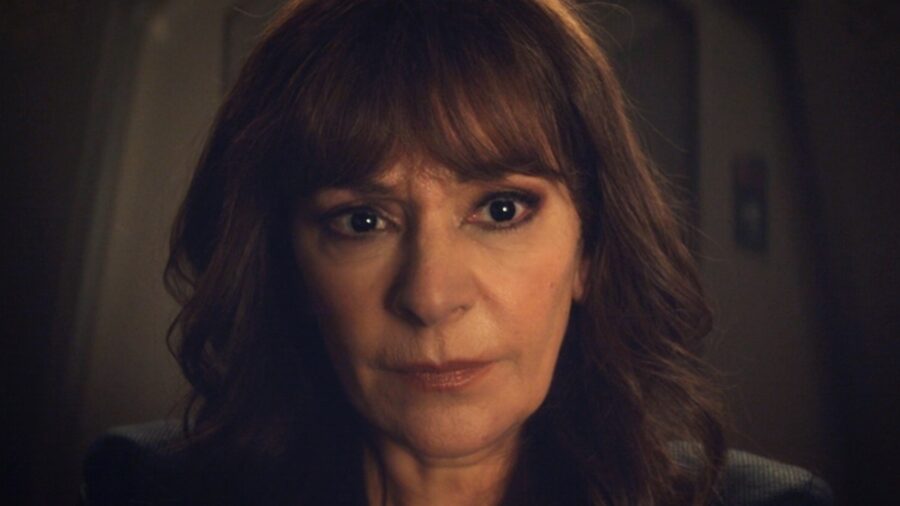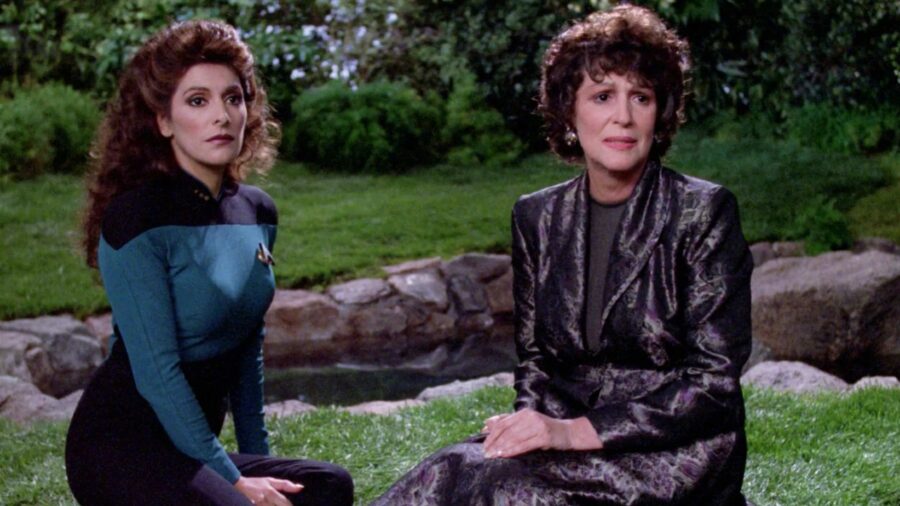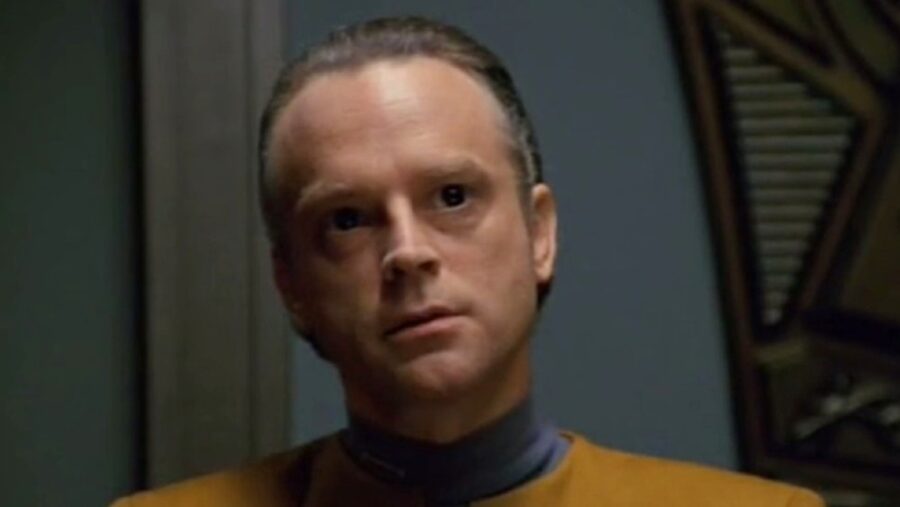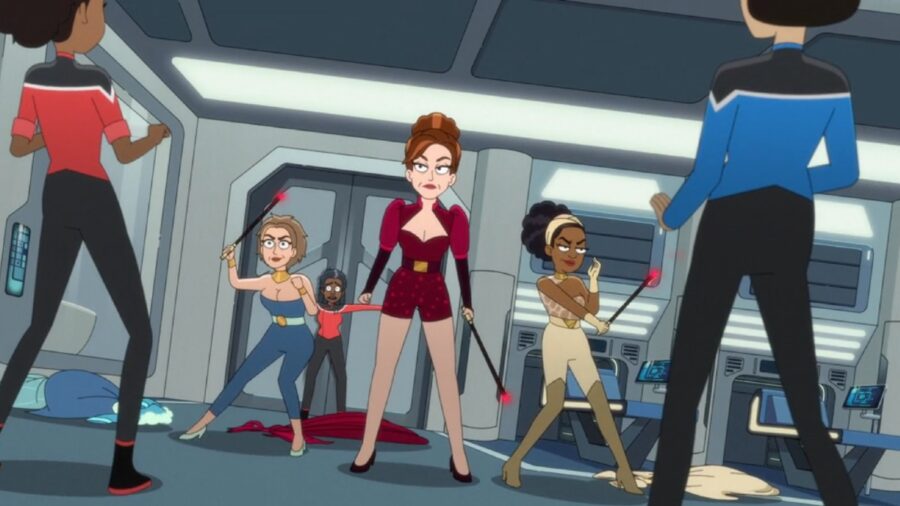Star Trek Betazoids: The Mind-Reading Enigmas Explained

What if one of the biggest parts of the Star Trek franchise was also something fans hardly knew anything about? That’s the case with the Betazoids: on Star Trek: The Next Generation, half-Betazoid Counselor Troi was a main character, and we frequently had cameos from her full-Betazoid mother Lwaxana. Now that this race is popping up with some added wrinkles in Paramount Plus shows like Lower Decks, we decided to write the definitive primer on this enigmatic race of telepaths.
Most full-blooded Betazoids have powerful telepathy that can help them read the minds of others and even influence their brains.
One obvious fact about this particular Star Trek race is that Betazoids look exactly like humans. In fact, the only difference is that Betazoid irises tend to be completely black. Strictly speaking, that only applies to those who are at least half-Betazoid: the half-Betazoid Deanna Troi has black irises, but that wasn’t the case with her daughter Kestra Troi-Riker, someone who was only one-quarter Betazoid.
Speaking of biology, the most striking feature of Star Trek’s Betazoids is their telepathic abilities. Most full-blooded Betazoids have powerful telepathy that can help them read the minds of others and even influence their brains.
Incidentally, “brain” is relative: given that Betazoids can get impressions even from creatures like Q (who don’t have a biology as we understand it), it’s clear that the Betazoid ability to “read someone’s mind” is not limited to whether they have a flesh-and-blood brain to scan. Deanna Troi was even able to read the android Data’s emotions when he installed an emotion chip.
Lwaxana Troi is an example of someone born with the potential for particularly strong telepathic ability, but there are other Betazoids (including Lon Suder from Voyager) who never develop strong abilities.

Somewhat confusingly, though, Star Trek has implied that certain biological aspects of other races can make them difficult (and sometimes even impossible) for Betazoids to read. The most prominent example would be the Ferengi: Betazoids can’t read their minds, and Data theorized this might be due to the unique structure of their brains. Betazoids also cannot read Changelings’ minds, and that may or may not have something to do with the unique shapeshifting powers they possess.
So far, we’ve been focusing on the telepathic abilities possessed by the average Betazoid, but Star Trek has made it clear that this ability may be stronger or weaker due to a variety of factors. For example, Lwaxana Troi is an example of someone born with the potential for particularly strong telepathic ability, but there are other Betazoids (including Lon Suder from Voyager) who never develop strong abilities.

Most Betazoids don’t know how strong their genetically inherited abilities will be until telepathy kicks in around adolescence, though some Betazoids are born with these abilities and typically grow up with mental problems because they have trouble screening out the thoughts of others.
In the Star Trek: The Next Generation episode “Manhunt,” we discover that Betazoids go through a “phase” similar to human menopause that can both dampen their telepathic abilities and increase their sex drive.
Other factors affecting the telepathic ability of Star Trek’s Betazoids include how much they have trained in that ability. While Betazoids can breed with humans and seemingly most humanoids, the children often experience a diminished telepathic ability. The most obvious example in Star Trek is Deanna Troi, who is an empath but not a full telepath because she had a human father.
Most of the other details we know about these aliens come from various Star Trek episodes that the franchise rarely (if ever) picked up on again. For example, Lwaxana Troi has publicly thanked “the four deities” for positive outcomes, but we don’t know much about Betazoid religion.
Lwaxana Troi insisted on an alleged Betazoid tradition of giving thanks for her food by having a servant ringing a chime while she eats, something that hasn’t really been practiced by Deanna or other onscreen Betazoids.
In the Star Trek: The Next Generation episode “Manhunt,” we discover that Betazoids go through a “phase” similar to human menopause that can both dampen their telepathic abilities and increase their sex drive. This never really came up after TNG, even in the recent Lower Decks episode featuring a trio of Betazoid “diplomats” who were revealed to be agents of the Betazoid Intelligence Agency.
Even though Captain Freeman referenced all of them as “gals of a certain age,” and even though their sex drives certainly seemed in high gear, there was no mention of the phase and certainly no reduction in telepathic ability.

Still, Star Trek has been consistent about certain aspects of Betazoid tradition, including the fact that a planet of telepaths would develop a very open and honest culture among themselves. While the planet has hereditary nobility (just ask Daughter of the Fifth House Lwaxana) and a matriarchal government, cultural ceremonies such as weddings are used to remind everyone involved they are on the same social footing and have nothing to hide.
Accordingly, weddings are conducted fully nude, which is why Captain Picard joked about hitting the gym ahead of Riker and Troi’s Betazed wedding ceremony in Star Trek: Nemesis.












